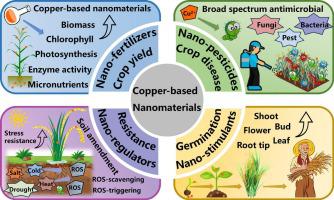当前位置:
X-MOL 学术
›
Sci. Total Environ.
›
论文详情
Our official English website, www.x-mol.net, welcomes your feedback! (Note: you will need to create a separate account there.)
Copper-based nanomaterials: Opportunities for sustainable agriculture
Science of the Total Environment ( IF 9.8 ) Pub Date : 2024-03-26 , DOI: 10.1016/j.scitotenv.2024.171948 Chengpeng Su , Anqi Chen , Weiyu Liang , Wenwen Xie , Xiang Xu , Xiuping Zhan , Wei Zhang , Cheng Peng
Science of the Total Environment ( IF 9.8 ) Pub Date : 2024-03-26 , DOI: 10.1016/j.scitotenv.2024.171948 Chengpeng Su , Anqi Chen , Weiyu Liang , Wenwen Xie , Xiang Xu , Xiuping Zhan , Wei Zhang , Cheng Peng

|
The exponential growth of the global population has resulted in a significant surge in the demand for food worldwide. Additionally, the impact of climate change has exacerbated crop losses caused by pests and pathogens. The transportation and utilization of traditional agrochemicals in the soil are highly inefficient, resulting in significant environmental losses and causing severe pollution of both the soil and aquatic ecosystems. Nanotechnology is an emerging field with significant potential for market applications. Among metal-based nanomaterials, copper-based nanomaterials have demonstrated remarkable potential in agriculture, which are anticipated to offer a promising alternative approach for enhancing crop yields and managing diseases, among other benefits. This review firstly performed co-occurrence and clustering analyses of previous studies on copper-based nanomaterials used in agriculture. Then a comprehensive review of the applications of copper-based nanomaterials in agricultural production was summarized. These applications primarily involved in nano-fertilizers, nano-regulators, nano-stimulants, and nano-pesticides for enhancing crop yields, improving crop resistance, promoting crop seed germination, and controlling crop diseases. Besides, the paper concluded the potential impact of copper-based nanomaterials on the soil micro-environment, including soil physicochemical properties, enzyme activities, and microbial communities. Additionally, the potential mechanisms were proposed underlying the interactions between copper-based nanomaterials, pathogenic microorganisms, and crops. Furthermore, the review summarized the factors affecting the application of copper-based nanomaterials, and highlighted the advantages and limitations of employing copper-based nanomaterials in agriculture. Finally, insights into the future research directions of nano-agriculture were put forward. The purpose of this review is to encourage more researches and applications of copper-based nanomaterials in agriculture, offering a novel and sustainable strategy for agricultural development.
中文翻译:

铜基纳米材料:可持续农业的机遇
全球人口的指数增长导致全球粮食需求大幅增长。此外,气候变化的影响加剧了害虫和病原体造成的农作物损失。传统农用化学品在土壤中的运输和利用效率极低,造成巨大的环境损失,对土壤和水生生态系统造成严重污染。纳米技术是一个新兴领域,具有巨大的市场应用潜力。在金属基纳米材料中,铜基纳米材料在农业中表现出了巨大的潜力,预计它将为提高作物产量和控制疾病等提供一种有前景的替代方法。本文首先对农业用铜基纳米材料的研究进行了共现和聚类分析。然后对铜基纳米材料在农业生产中的应用进行了全面综述。这些应用主要涉及纳米肥料、纳米调节剂、纳米兴奋剂和纳米农药等,用于提高作物产量、提高作物抗性、促进作物种子发芽、防治作物病害。此外,论文还总结了铜基纳米材料对土壤微环境的潜在影响,包括土壤理化性质、酶活性和微生物群落。此外,还提出了铜基纳米材料、病原微生物和作物之间相互作用的潜在机制。此外,综述还总结了影响铜基纳米材料应用的因素,并强调了铜基纳米材料在农业中应用的优势和局限性。最后对纳米农业未来的研究方向提出了展望。本综述的目的是鼓励铜基纳米材料在农业中的更多研究和应用,为农业发展提供新颖且可持续的策略。
更新日期:2024-03-26
中文翻译:

铜基纳米材料:可持续农业的机遇
全球人口的指数增长导致全球粮食需求大幅增长。此外,气候变化的影响加剧了害虫和病原体造成的农作物损失。传统农用化学品在土壤中的运输和利用效率极低,造成巨大的环境损失,对土壤和水生生态系统造成严重污染。纳米技术是一个新兴领域,具有巨大的市场应用潜力。在金属基纳米材料中,铜基纳米材料在农业中表现出了巨大的潜力,预计它将为提高作物产量和控制疾病等提供一种有前景的替代方法。本文首先对农业用铜基纳米材料的研究进行了共现和聚类分析。然后对铜基纳米材料在农业生产中的应用进行了全面综述。这些应用主要涉及纳米肥料、纳米调节剂、纳米兴奋剂和纳米农药等,用于提高作物产量、提高作物抗性、促进作物种子发芽、防治作物病害。此外,论文还总结了铜基纳米材料对土壤微环境的潜在影响,包括土壤理化性质、酶活性和微生物群落。此外,还提出了铜基纳米材料、病原微生物和作物之间相互作用的潜在机制。此外,综述还总结了影响铜基纳米材料应用的因素,并强调了铜基纳米材料在农业中应用的优势和局限性。最后对纳米农业未来的研究方向提出了展望。本综述的目的是鼓励铜基纳米材料在农业中的更多研究和应用,为农业发展提供新颖且可持续的策略。



























 京公网安备 11010802027423号
京公网安备 11010802027423号